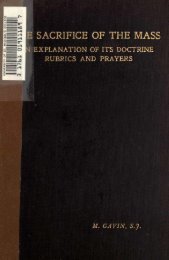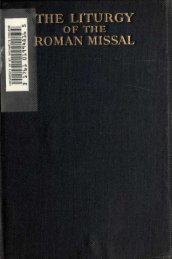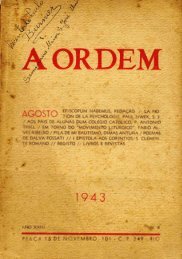E SACRIFICE OF THE MASS
E SACRIFICE OF THE MASS
E SACRIFICE OF THE MASS
You also want an ePaper? Increase the reach of your titles
YUMPU automatically turns print PDFs into web optimized ePapers that Google loves.
<strong>THE</strong> CEREMONIES <strong>OF</strong> HIGH <strong>MASS</strong>. 157<br />
a substitute for those lights which are prescribed by the<br />
Church s ritual. 1 Six candles are lighted at High Mass,<br />
and seven at a High Mass celebrated by a Bishop. The<br />
origin of this custom takes us back to the ninth century<br />
after Christ. We cannot do better than quote a passage<br />
from a most interesting and instructive book on the<br />
Ceremonies of Holy Week published in 1902. In<br />
speaking of the service of the Three Lessons on Good<br />
Friday, the author refers (p. 4) to a time in the early<br />
Church when the Chief Pontiff and his attendants made<br />
their solemn entry into the sanctuary for High Mass.<br />
"In the sacristy," writes Father Thurston, "near the<br />
entrance of the Lateran Basilica, the Pontiff assumed<br />
the sacred vestments. There he took his place in the<br />
procession to the altar, being supported on his right by<br />
his archdeacon and on his left by the second deacon,<br />
and preceded by the subdeacons, one of whom, who was<br />
inferior in grade to the seven regionary 2 subdeacons,<br />
swung a smoking censer. At the head of the procession<br />
walked the seven regionary acolytes bearing lighted<br />
candles. . . . The seven candles of the acolytes, which<br />
were eventually ranged in a row on or before the altar,<br />
explain in the clearest way the origin of the seven<br />
candles in a Pontifical High Mass, and through an<br />
obvious differentiation, the origin of the six candles on<br />
the altar in a High Mass which is not pontifical."<br />
1 To the question<br />
" Utrum<br />
lux electrica adhiberi possit in<br />
Ecclesiis," it was answered by the Congregation of Rites, "Ad<br />
cultum, negative: ad depellendas autem tenebras ecclesiasque<br />
splendidius illuminandas, affirmative ; cauto tamen, ne modus<br />
speciem prae se ferat theatralem." (June 4, 1895.)<br />
a<br />
Pope St. Fabian in the third century divided Rome into seven<br />
"<br />
ecclesiastical regions." Each region had a deacon and subdeacon<br />
of its own, with acolytes under them. These clerics were<br />
called<br />
"<br />
regionaries ;<br />
"<br />
sequentes, "supernumeraries."<br />
others of the same grade were called






